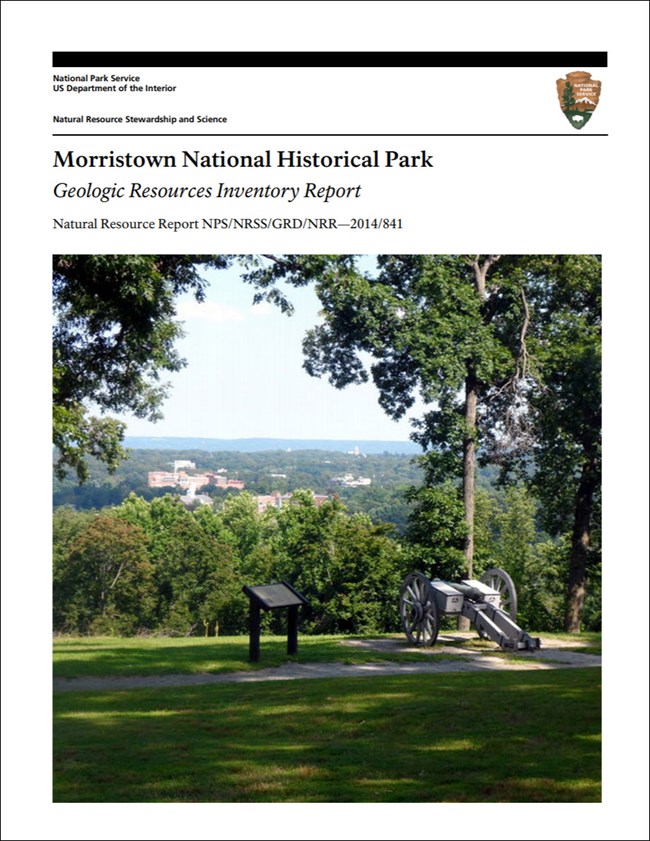Last updated: July 11, 2024
Article
NPS Geodiversity Atlas—Morristown National Historical Park, New Jersey
Geodiversity refers to the full variety of natural geologic (rocks, minerals, sediments, fossils, landforms, and physical processes) and soil resources and processes that occur in the park. A product of the Geologic Resources Inventory, the NPS Geodiversity Atlas delivers information in support of education, Geoconservation, and integrated management of living (biotic) and non-living (abiotic) components of the ecosystem.

Introduction
Morristown National Historical Park (MORR) encompasses the 18th century village of Morristown, located approximately 48 km (30 mi) west of New York City in Morris County, New Jersey. Authorized as the nation’s first designated National Historical Park on March 2, 1933, MORR contains about 692 hectares (1,711 acres) and protects the structures, features, archeological resources, and collections of the Continental Army winter encampments of 1777–1778 and 1779– 1780, the headquarters of General George Washington, and related American Revolutionary War sites at Morristown (Thornberry-Ehrlich 2014; National Park Service 2016a). The historical park is comprised of four separate units that feature encampments, historic houses, and fortifications that sheltered, protected, and sustained General Washington and his army: Washington’s Headquarters; Fort Nonsense; Jockey Hollow; and the New Jersey Brigade area. During the winter encampment of 1779–1780, General Washington demonstrated leadership in keeping the Continental Army intact against numerous difficulties that included disease, food shortages, expiring enlistments, and the worst winter of the century (National Park Service 2018).
Geologic Setting
Morristown National Historical Park is situated along the tectonic boundary between the Reading Prong and Piedmont physiographic provinces, two regions of drastically different lithologies separated by the Ramapo Fault. The geology of MORR can be subdivided into three main types of rock: (1) ancient Mesoproterozoic metamorphic and igneous strata; (2) Jurassic sedimentary rocks; and (3) young, unconsolidated surficial deposits of Quaternary age. The oldest bedrock of MORR is located west of the Ramapo Fault and consists of Mesoproterozoic granitic and gneissic rocks associated with the Byram Intrusive Suite and Losee Metamorphic Suite. Sandstone, siltstone, and mudstone of the Jurassic Boonton Formation are mapped on the eastern side of the Ramapo Fault underlying the Washington’s Headquarters Unit. Multiple glacial advances during the Pleistocene reshaped the landscape of MORR and deposited thick sequences of unconsolidated till that were subsequently reworked by streams and rivers into alluvial, swamp, terrace, and slope deposits (Thornberry-Ehrlich 2014).
Regional Geology
Morristown National Historical Park is in the New England Highlands Physiographic Province and adjacent to the Piedmont Physiographic Province. The park shares its geologic history and some characteristic geologic formations with a region that extends well beyond park boundaries.
- Scoping summaries are records of scoping meetings where NPS staff and local geologists determined the park’s geologic mapping plan and what content should be included in the report.
- Digital geologic maps include files for viewing in GIS software, a guide to using the data, and a document with ancillary map information. Newer products also include data viewable in Google Earth and online map services.
- Reports use the maps to discuss the park’s setting and significance, notable geologic features and processes, geologic resource management issues, and geologic history.
- Posters are a static view of the GIS data in PDF format. Newer posters include aerial imagery or shaded relief and other park information. They are also included with the reports.
- Projects list basic information about the program and all products available for a park.
Source: NPS DataStore Saved Search 3021. To search for additional information, visit the NPS DataStore.
A NPS Soil Resources Inventory project has been completed for Morristown National Historical Park and can be found on the NPS Data Store.
Source: NPS DataStore Saved Search 3068. To search for additional information, visit the NPS DataStore.
Related Articles
Morristown National Historical Park
National Park Service Geodiversity Atlas
The servicewide Geodiversity Atlas provides information on geoheritage and geodiversity resources and values within the National Park System. This information supports science-based geoconservation and interpretation in the NPS, as well as STEM education in schools, museums, and field camps. The NPS Geologic Resources Division and many parks work with National and International geoconservation communities to ensure that NPS abiotic resources are managed using the highest standards and best practices available.


